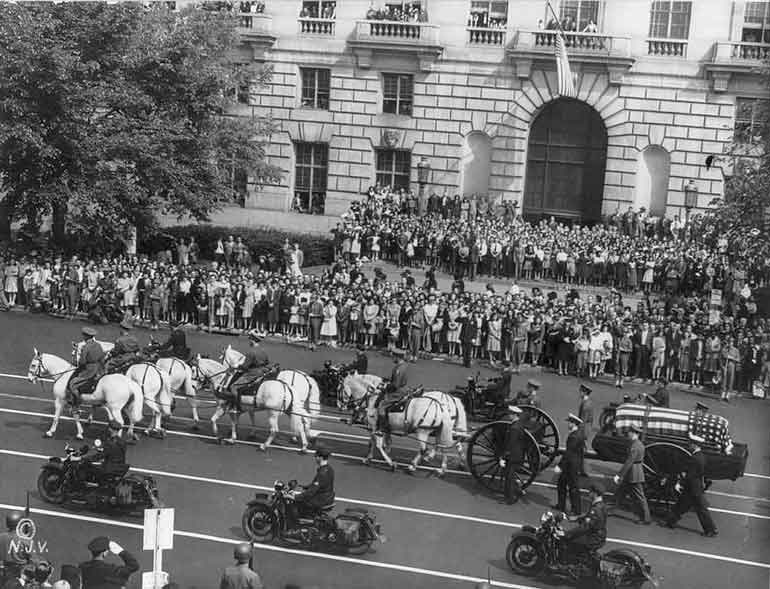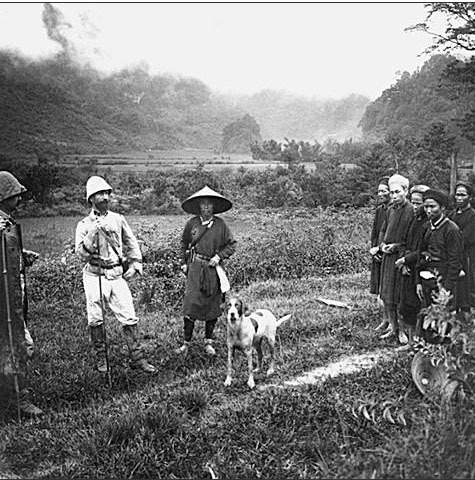I) End of the Hot War
A) Victory in Europe – pretty much a forgone conclusion after the successful landing at Normandy
1) Atomic Bomb – the Manhattan Project was able to produce three atomic bombs by the summer of 1945
2) Why Japan?
(a) Payback to Japanese for Pearl Harbor , Bataan (death march), other atrocities
(b) Limit the amount of territory that would have to be surrendered to the Soviet Union for its “sphere of influence” in Asia
(c) Limit number of American casualties – fears of massive casualties from an invasion of Japan
(d) Racist feeling toward Japanese, which also fueled earlier movement to use of internment camps.
3) “Spheres of influence” – agreement between FDR, Churchill, and Stalin that would provide Soviet Union control of the countries immediately were surrounding the country so that the Soviets could maintain a buffer to decrease the likelihood that they would be invaded.
4) Soviet entry into Pacific – the Soviet Union was scheduled to begin its role in the PTO by August 8
5) Hiroshima August 6, 1945 ; 80,000 people burned to death instantly, tens of thousands died soon afterward from the effects of radiation; five square miles were leveled by the blast
6) Nagasaki August 8, 1945 ; 35,000 were killed instantly; 1 ½ square mile was leveled.
7) Surrender – surrender formally signed on September 2, 1945 —VJ Day
C) Alternatives – Smithsonian controversy over the Enola Gay display; most veterans of the war do not want to hear of any alternatives to dropping the bombs, because they believe that dropping the bombs saved their lives. There was strenuous opposition on the part of the generals advising Truman, however, who did not believe the intentional slaughter of civilians, which was clearly going to be the case in the two targets chosen in Japan
1) No invasion was planned until November 1945
2) Japan
D) Allied fallout
1) Death of FDR – dynamics between the leaders of Great Britain, Soviet Union, and United States changed greatly with death of FDR; Truman less confident of abilities than FDR, nor did he initially inspire much confidence. Truman was much more likely to follow the lead of Churchill, who was vehemently anti-Communists; Truman was anti-Communist himself, and distrusted Stalin greatly.
I) The Cold War in Europe
A) Truman and Communism
1) Distrust of Stalin – although FDR had developed a relationship of statecraft with Stalin, Truman did not develop the same level of trust as his predecessor; in fact, Truman believed that Stalin was one of the most dishonest, evil men that he had ever known (a fact that is hard to argue with, certainly).
(a) Cancellation of Soviet Lend-Lease Aid – at war’s end, Soviets denied any further access to lend-lease aid, which shut off their access to US military hardware.
2) Influence of Winston Churchill – Churchill had never put the level of trust in Stalin that FDR did, so when Truman became distrustful of Stalin, Churchill was there to feed those fears, which he shared with Truman.
(a) “Iron Curtain” speech – in a speech at a tiny college near St. Louis, Churchill delivered his famous Iron Curtain speech, where he encouraged isolating Western European countries from those under the domination of the Soviet Union.
3) Nuclear terror – the US insisted, since it was the lone country that could possibly hold the interests of the whole world ahead of its own self-interests (or that its self-interests alone were of concern to the rest of the world), insisted that this country, alone, should control these new weapons of mass destruction.
(a) Soviets successfully test Atomic bomb in 1949 – the acquisition of nuclear technology by the Soviet Union fed fears of the red menace at home. Part of this hysteria led to the construction of backyard bomb shelters, and the identification of public buildings that could also serve as temporary bomb shelters.
(b) Escalation by the US – after the Soviet Union acquired nuclear capability, the US went ahead with the development of the more powerful Hydrogen bomb, which had ten times the killing power of the atomic bomb.
4) Policy of containment – an increased confidence on the part of the military and diplomatic elite after the US successes in the second World War led to a belief that the military might, or the threat of the use of military might, of the US could “contain” the influence of the Soviet Union as it was constituted in 1946.
(a) George F. Kennan – was the diplomat stationed in Moscow who came up with many of the theories, and the term, which we now refer to as constituting the policy of containment
(b) Truman Doctrine – the Truman doctrine went hand-in-glove with the policy of containment. The Truman doctrine pledged to aid countries in their fight against “communist aggression.”
(i) Plan was formulated in response to an ongoing civil war in Greece, which pitted forces that had fought against fascists in the world war (led by a number of communists) against those forces that had collaborated with the fascists forces (which of course was anti-communist, and therefore backed by the US government). The aid the anti-communist forces received helped them to prevail in the struggle.
(c) Marshall Plan – named after Truman’s secretary of state, Gen. George C. Marshall; was a $16 billion dollar plan (that’s $140 billion in today’s dollars) plan for the reconstruction of Europe. Money was even offered to countries in the so-called Soviet bloc, if they would agree to strengthen economic ties with the West. This plan worked great for countries with strong social democratic traditions (like Great Britain, France), but it mainly strengthened the grip of right-wing dictators around the world.
II) Cold War in Asia – The Cold War was by definition a global conflict, and the United States took a much more active role in Asia after the World War than it ever had before—perhaps because the Soviet Union, like the United States, also was a Pacific Ocean power.
A) Fall of China – the Red Army of Mao tse-Chung prevailed over the forces of Chang Kai-shek in 1949, and Chang and his followers were forced to withdraw to the island of Formosa, just off the Chinese coast. Chang was a venal, corrupt leader, who lost this war despite the aid that he was provided by the United States; however, in domestic politics, Truman was blamed for the “loss” of China, and these domestic pressures in turn prompted and reinforced Truman’s commitment to militarily aid anti-communist governments in Asia
1) NSC-68 – a proposal by the National Security Council to triple the amount of money that the United States spent on defense. This increased defense spending in fact acts as a sort of welfare program for selected parts of the US industrial complex (mainly aeronautics, but also some other manufacturing concerns).
B) The “Domino Theory” – the need to oppose communism anywhere and everywhere it arose was fed by the fear that if communism were tolerated in one country, it would spread country by country, like dominoes toppling one after another, until the threat undermined the freedoms of the people of the United States.
C) Korea – Kim IL Sung attempted to reunite his country, which had been portioned at the insistence of the United States along the 38th parallel. The US suspects that the Soviet Union is responsible for this intrigue, and immediately begins aiding anti-communist forces in the South, both with material and men. After some initial difficulties, the US military operation after a brilliantly executed flanking maneuver utilizing a large scale amphibious assault was quite successful, and the combined forces are able to push the so-called North Koreans back well above the 38th parallel—in fact, in direct contradiction of the orders of his commander in chief, Douglas McArthur pushed the North Korean forces above the area claimed by China as its border with North Korea—at which time the Chinese Red Army joined the fight against the Allied forces. The US was initially overwhelmed, but eventually recovered, and the fighting bogged down at the end of the year about where it had started, at the 38th parallel.
D) Wars to end colonial domination – Because of the focus upon the battle against communism, the US government tended to support the re-establishment of colonial rule around the globe, rather than the indigenous populations which looked to the Declaration of Independence and the US Constitution for inspiration.
1) The French in Indochina
(a) Opposed by the Vietminh – the Vietminh, led by Ho Chi Minh, had been supported by the US during the war against Japan, even though the OSS was aware that Ho was a communist. This attitude quickly changed after the conclusion of the war, however, and the United States supported France’s efforts to re-establish control over the Indochina peninsula. Because of the strong resistance of the Vietminh, the US had to increase the support it furnished the French throughout the early 1950s, even going so far as providing advisors. In 1954, however, a large French force was surrounded near a little hamlet called Dien Bien Phu, and forced to surrender. The US quickly stepped in here, and declared that the country of Vietnam should be divided along the 49th Parallel, into North and South Vietnam, until a plebiscite could be held to choose a popularly elected government. Former collaborators ran the south with the French, some of who had even converted to Catholicism. The promised election never happened.











No comments:
Post a Comment